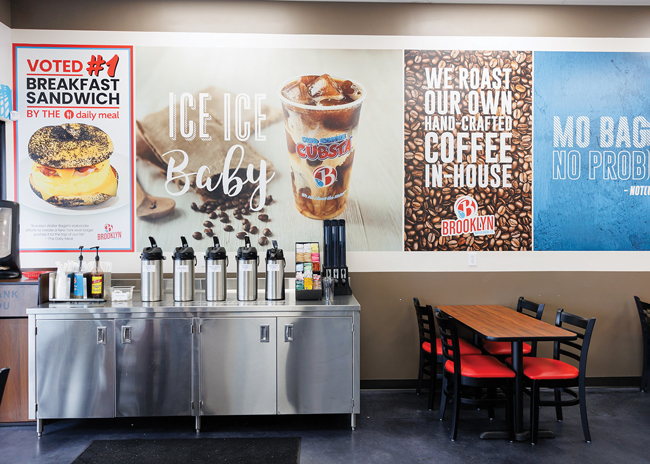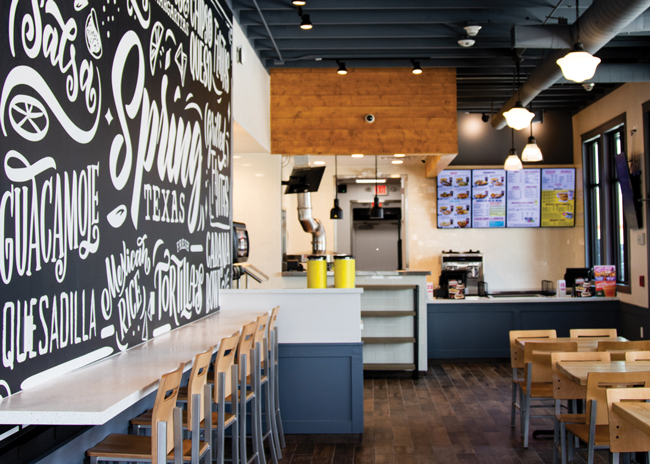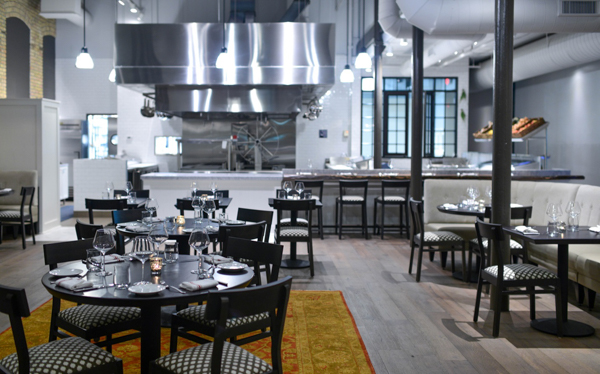Venues that specialize in breakfast and lunch operate differently from those that focus on dinner. In the early dayparts, guests tend to be in a bigger rush to place orders, get their food, and move on with the demands of their day. With smaller average guest checks, breakfast and lunch establishments achieve success with higher volumes, serving more customers per hour than a comparably sized dinner restaurant.
Thus, breakfast and lunch restaurants stress high efficiency service and the restaurant’s design must support this goal. Aesthetics and furnishings in food and beverage venues that serve the early dayparts also differ from most dinner-focused locations. To be sure, breakfast and lunch connote a different vibe from dinner, and while some design touches vary by brand, many principles are common throughout this market segment.
In the back of the house, layout of functions is critical to optimizing efficiency for all restaurants, but for breakfast and lunch venues even small changes to the kitchen layout are important.
 Brooklyn Water Bagel positions a coffee dressing station close to the main door so that guests can finish their drinks and quickly exit. Image courtesy of Orlando Weekly
Brooklyn Water Bagel positions a coffee dressing station close to the main door so that guests can finish their drinks and quickly exit. Image courtesy of Orlando Weekly
Off-Premises Trends
“The breakfast daypart has a little more urgency,” says John Ramsay, director of franchise sales and development, Taco Cabana. The Texas-based chain, open for breakfast, lunch and dinner, recently unveiled a new design prototype that adds a second prep line dedicated to drive-thru orders. “This was driven by increased off-premises orders that have become a bigger part of business since Covid,” Ramsay says. More than 60% of orders are now drive-thru, and morning business is especially brisk with patrons grabbing a quick bite and a coffee on their way to the office. The additional prep line allows staff to focus more intently on these orders.
Taco Cabana also made a notable change to its exterior layout to accommodate its bustling drive-thru business: the addition of a second car stack for ordering. After guests place their order from either drive-thru line, they merge into one lane to pay for and receive their food. The point is to engage with guests sooner. “It’s psychological,” Ramsay says. “People feel better after they place an order than if they are waiting to place their order behind somebody else.”
Increased online and mobile ordering prompted a prototype design change at Brooklyn Water Bagel, a Florida-based chain that offers breakfast and lunch. The brand, which does not have drive-thru service, added drive-up pickup windows for those who place orders online. Today, about 30% of Brooklyn Water Bagel’s sales come from third-party delivery, a percentage that has been growing in recent years, according to Dan Smith, CEO. To support efficient delivery service, Brooklyn Water Bagel dedicates a line by the POS station for delivery and takeout. The chain, like Taco Cabana, also revamped its prep area in recent years, adding a second line dedicated to catering, pickup and third-party delivery orders.
 Taco Cabana’s aesthetics include bright walls and natural-looking materials. Image courtesy of Taco Cabana
Taco Cabana’s aesthetics include bright walls and natural-looking materials. Image courtesy of Taco Cabana
Coffee — and Efficiency — are Keys
Coffee orders peak during the breakfast rush, so brands allocate space to accommodate the demand. “We have an area where guests can create their coffee the way they want it,” Smith says. To the left of the order queue and close to the entrance, Brooklyn Water Bagel positions a coffee station with several creamers and sweeteners for guests to quickly finish their coffee orders and exit the premises. Taco Cabana sites typically position coffee pump pots next to the pickup window. Staff at the windows can quickly fill a coffee order from these beverage holders without having to walk into the kitchen where coffee makers are stationed. The pump pots take up less room than coffee makers, saving precious space at the pickup window station.
Most breakfast and lunch restaurant brands have reduced the square footage of new locations in recent years, points out Corey Dunne, co-founder of the design firm Dunne Kozlowski. For instance, Taco Cabana’s new prototype measures about 2,400 square feet compared to one devised a few years ago that totaled about 3,500 square feet. Given this trend, optimizing the use of every square foot is essential. In the back of the house, many restaurants try to have a “Swiss-army-knife approach” to choosing equipment, Dunne says. They select cooking gear that can be used to prepare multiple offerings throughout the whole course of the day. “You might have a piece of equipment that is used just certain times of day, but if you can get as much use out of equipment as possible, that is ideal,” Dunne says.
As the clock heads toward noon and breakfast fare turns over to lunch offerings, brands repurpose equipment for midday meals. At Taco Cabana, for example, the flat grill where breakfast items such as eggs and bacon shifts to preparing vegetables. The open flame grill ramps up to cook meat, and the lunch items replace breakfast ingredients in the warming holds on the makeline. “The beauty is that this works seamlessly instead of having to use specialized equipment,” Ramsay says.
Some brands do rely on specialized equipment and finagle how best to position it. Taco Cabana recently moved its semi-automated tortilla maker from the cookline in the back of the kitchen to the makeline positioned closer to the front of the house. “This reduced service times,” Ramsay says. “Staff only need to walk two steps to get to the machine.” These types of relatively minor adjustments can make order fulfillment faster in high-volume environments and can help to reduce the amount of labor needed to staff a site.
Full-service breakfast and lunch establishments have layout strategies to boost efficiency that may not work for restaurants focused on dinner service. For example, breakfast and lunch spots often have multiple server stations spread out throughout the dining area. These posts include tableware and water pitchers and might even include other beverages such as soda or coffee. The goal is to minimize steps for servers so that they can respond faster to guests’ wishes.
Dinner establishments tend to shy away from dispersing multiple server stations to promote a calmer vibe. “With dinner, you are more focused on the guest experience, with efficiency a little less important,” Dunne says. The same philosophy applies to dish dumps, which tend to promote some clanging of plates and silverware. Guests are more apt to tolerate the noise in the earlier dayparts. “For dinner, that might be frowned upon,” Dunne says.
 Kanela Breakfast Club placed a pastry case next to the POS station to encourage sales of their popular treats. Image courtesy of Kamil Radziszewski, Luxe Point Media
Kanela Breakfast Club placed a pastry case next to the POS station to encourage sales of their popular treats. Image courtesy of Kamil Radziszewski, Luxe Point Media
Aesthetic Concerns
Lighting typically differs for breakfast and lunch eateries as compared to dinner establishments. “How a place looks in daylight is different from restaurants that are only open in the evening,” says Rocco Laudizio, founder and principal, Slick+Designusa. Many breakfast and lunch spots allow daylight to flood their spaces and augment the natural light with subdued artificial light. For much of the year, the sun is high in the sky during most breakfast and lunch hours, so there is less need for curtains and shades to shield the sun, Dunne notes. In winter, the angle of sunlight is lower, so shielding may be needed then. In the late afternoon and early evening, dinner restaurants often use heavy curtains to block the rays of the setting sun.
The color and material palette that designers employ for establishments focused on morning and afternoon service tends to be lighter than dinner-only restaurants. “Earlier in the day, people are looking for lighter meals,” Dunne says. Lighter colors, then, are in sync with the fare. A common aesthetic theme is “light and breezy, sometimes coastal,” Dunne says. “A lot of times, we use earth tones.” At 4201 Congress, a Charlotte, N.C., restaurant, Dunne employed rattan and lots of plants in ceramic vases and pots to create an ambiance in sync with “guests coming in wearing sun dresses.”
At Kanela Breakfast Club in Chicago, Laudizio specified white subway tile for the walls, and custom black and white mosaic tiles. The predominately light coloring brightens a long, narrow space with windows only on the front wall. Laudizio used natural walnut and ash wood on tabletops, a soffit and the bar front as accents.
Light and breezy also describes typical breakfast and lunch restaurant artwork. Pictures of breakfast fare are common decor for breakfast eateries. Brooklyn Water Bagel chose a different approach to artwork, paying homage to old Brooklyn with numerous vintage black and white photos of the borough. This theme speaks to the brand, which prides itself on its artisanal bagels based on recipes and cooking techniques established in early 20th century Brooklyn. Giving a nod to modern Brooklyn, as well, the chain displays photos of the new Brooklyn skyline.
Furniture choices tend to vary a bit according to the business plan. Many brands specify seating with minimal cushioning, expecting guests to keep their stays short. Other brands, such as Brooklyn Water Bagel, encourage guests to linger with friends or even hold business meetings on-premises. A typical Brooklyn Water Bagel store seats 30 to 40, which can include outdoor seating. Smith describes the seating as comfortable, but not as plush as at a fine dining restaurant. Some locations have booths, and some have a communal area with a high-top bar that offers charging stations. “You can comfortably stay as long as you want,” Smith says.
At most eateries, few breakfast and lunch guests stay for more than an hour, but even for those that do linger a bit, efficient service is always a design priority. After all, in our fast-paced society, time is the most precious commodity and guests value brands that respect this principle.



